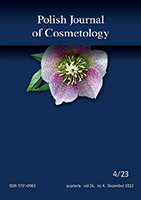search by
Copyright @ Pol J CosmetolAloe ophthalmic ointments with neomycinTeresa Bujak, Anna Kodym, Marian M. Zgoda, Bahaj Badreddine Katedra Farmacji Stosowanej, Uniwersytet Medyczny w Łodzi Summary Aloe extract has antibacterial, anti-inflammatory, regenerating and light-protective properties. According to literature data, a Russian preparation Extractum Aloe is an equivalent of Biostymina applied as a stimulant, recommended to be used together with drugs of causal activity. When administered parenterally, it increases immunity to infection and is effective in ophthalmic diseases: in blepharitis, conjunctivitis, keratitis, in retinal diseases and in short-sightedness in children and adolescents. A technology of a few ophthalmic ointments with aloe and aloe and neomycin has been worked out taking into account synergism of aloe and neomycin anti-inflammatory activity. The aim of the study was to determine pharmaceutical availability of aloenin in freshly produced model aloe ointments containing dry extract from Aloe Arborescens Mill leaves. Material and methods. A technology of model ophthalmic ointments with aloe and aloe with neomycin has been worked out taking into account synergism of aloe and neomycin anti-inflammatory activity. An analysis of aloenin pharmaceutical availability in ointments was carried out with the static method based on the dialysis of an active substance through semipermeable membrane SERVAPOR in Mutimer apparatus. Direct spectrophotometric method was used in chemical analysis to define active substances converted to aloenin. Pharmaceutical availability of the tested ointments was determined with biopharamaceutical parameters i.e. constant of release rate (k) and half-time of release (t50%). The results of the tests of aloenin content in the analysed material enable to include this compound to a group of compounds dominating in the chemical composition of Aloe Arborescens plants grown in greenhouses of Herbal Works "Herbapol" S.A. in Klęka. On the basis of aloenin release from aloe ointments, the usefulness of the suggested vehicles was also investigated, as well as mutual effect of neomycin and the components of dry aloe extract. Furthermore, exclusion of possible pharmaceutical interactions between neomycin and dry extract was considered in the tested ointments. Conclusions. The selected SERVAPOR dialysis membrane gave comparable results in the determinations of pharmaceutical availability and it is very useful in the testing of pharmaceutical availability of aloenin from ointments. Aloe extract affects the increase of microbiological activity of neomycin in ointments (initial microbiological investigations proved that), which fully justifies such combination of components and their application in the treatment of eye diseases. Key words: Aloes, Aloe arborescens, aloe ointments, aloe ointments with neomycin, pharmaceutical availability, aloenin |




